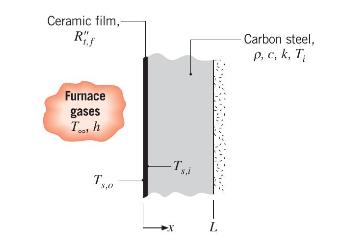A plane wall of a furnace is fabricated from plain carbon steel (left(k=60 mathrm{~W} / mathrm{m} cdot
Question:
A plane wall of a furnace is fabricated from plain carbon steel \(\left(k=60 \mathrm{~W} / \mathrm{m} \cdot \mathrm{K}, ho=7850 \mathrm{~kg} / \mathrm{m}^{3}, c=430\right.\) \(\mathrm{J} / \mathrm{kg} \cdot \mathrm{K})\) and is of thickness \(L=15 \mathrm{~mm}\). To protect it from the corrosive effects of the furnace combustion gases, one surface of the wall is coated with a thin ceramic film that, for a unit surface area, has a thermal resistance of \(R_{t, f}^{\prime \prime}=0.01 \mathrm{~m}^{2} \cdot \mathrm{K} / \mathrm{W}\). The opposite surface is well insulated from the surroundings.

At furnace start-up the wall is at an initial temperature of \(T_{i}=300 \mathrm{~K}\), and combustion gases at \(T_{\infty}=1300 \mathrm{~K}\) enter the furnace, providing a convection coefficient of \(h=30 \mathrm{~W} / \mathrm{m}^{2} \cdot \mathrm{K}\) at the ceramic film. Assuming the film to have negligible thermal capacitance, how long will it take for the inner surface of the steel to achieve a temperature of \(T_{s, i}=1000 \mathrm{~K}\) ? What is the temperature \(T_{s, o}\) of the exposed surface of the ceramic film at this time?
Step by Step Answer:

Fundamentals Of Heat And Mass Transfer
ISBN: 9781119220442
8th Edition
Authors: Theodore L. Bergman, Adrienne S. Lavine





